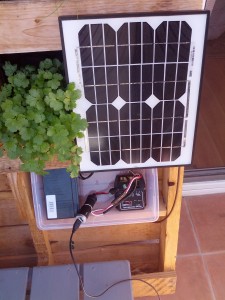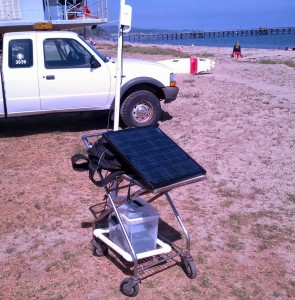I see a lot of posts on the Internet, especially on reddit, that ask about an emergency power solution for laptops, tablets, and phones. This is a pretty common kind of post on /r/solar. I usually just reply with a design for a basic solar powered charging system, but I decided to write this guide to small solar power systems instead.
This post is both a description of a basic solar charging station, and a comparison of commercial “solar generators” vs.a DIY alternative. The Goal Zero Yeti 400 Solar Generator the OP is considering costs $460 on Amazon, or $659.98 including a 30 Watt solar panel. To anyone who has built small-scale solar systems, these prices and the item description set off an alarm. This $460 product is named for what the manufacturer calls it’s peak capacity, 396Wh, the size of the battery in watt hours (12V, 33Ah). This is a relatively useless number. The name and price are both similar to the gas-powered portable generators sold by big box retailers, but the components are that of a relatively low cost off-grid solar system.What is in this solar generator?
- A solar charge controller.
- A 33Ah 12V battery.
- A 12V->5V regulator (2.1A peak) for USB ports.
- A 300W continuous output inverter for 110V AC.
So that’s what you get for $460! Notice that doesn’t include any solar panels.
You could build a similar system yourself for as little as $95 from Amazon, and a very basic knowledge of electronics. You just need to purchase the same components, individually. I’ve selected products from Amazon with similar specifications to the rated specs of the Goal Zero Yeti.
A 35Ah 12V battery $63.99
A solar charge controller $21.99
An 110V AC inverter (300W continous, equivalent to Goal Zero Yeti) $27.99
A 12V->5V USB car charger. (4.2A peak, twice the Goal Zero Yeti) $9.99
A female cigarette lighter port. $2.89
Total cost: $126.85. Even with another $30 for wires, connectors, or even a multimeter, you’re still saving at least $300 by building it yourself. Follow the instructions provided by the manufacturers to connect everything together, stay safe, and save money!
Goal Zero solar panels are similarly overpriced. Their Boulder 30W solar panel is $200 and has a similar weight and expected output as a $69 30W panel on Amazon. So to anyone considering a pre-made “solar generator”, know that you could build a DIY equivalent to a system sold for $659.98 with less than $200 in parts. If you’re looking for an emergency solar generator, build it yourself, ask questions on reddit, and save yourself $450!


